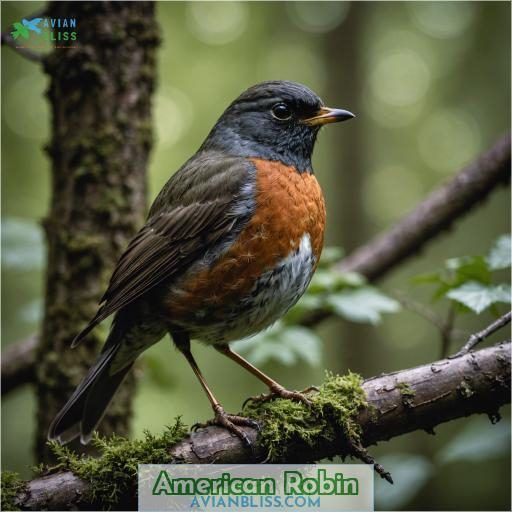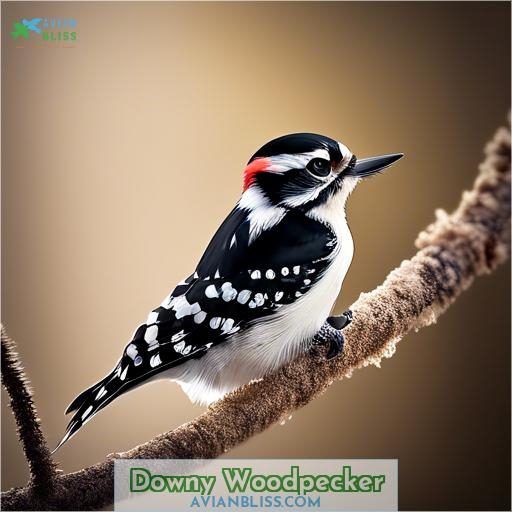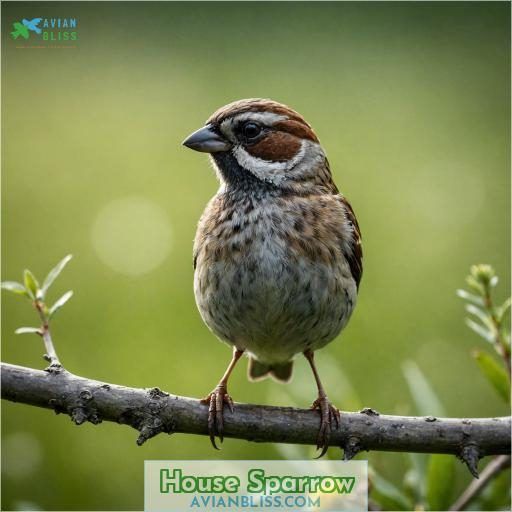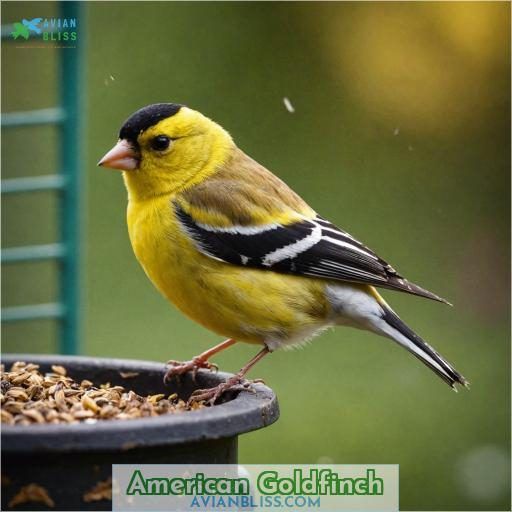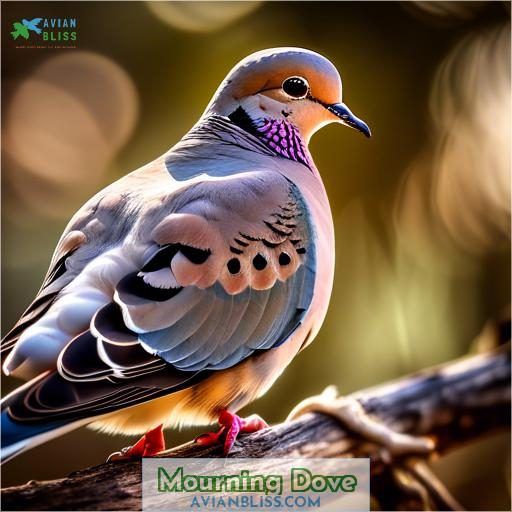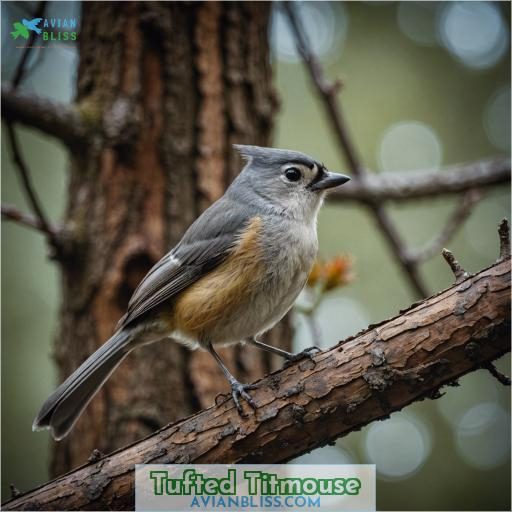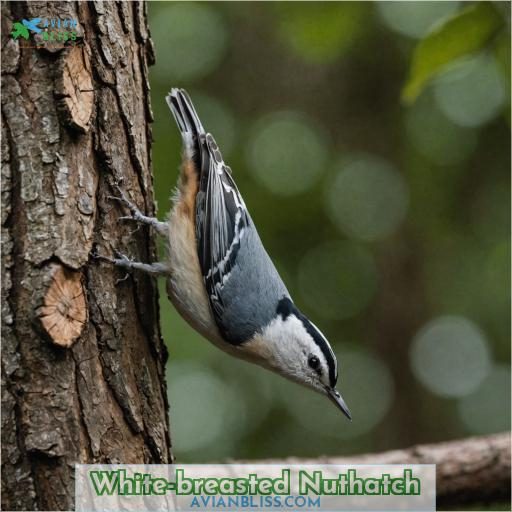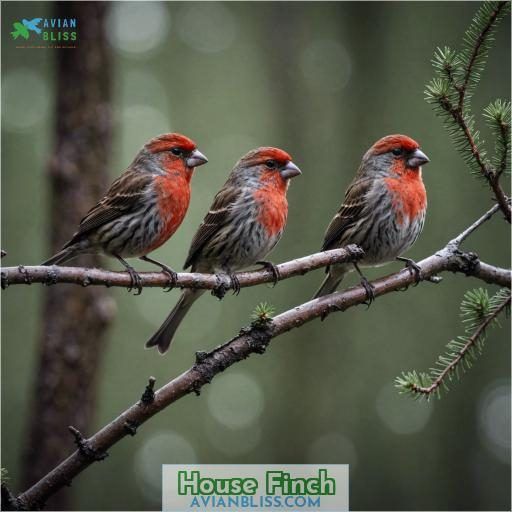This site is supported by our readers. We may earn a commission, at no cost to you, if you purchase through links.
 Your Illinois backyard attracts a vibrant assortment of feathered friends.
Your Illinois backyard attracts a vibrant assortment of feathered friends.
The brilliant red Northern Cardinal and cheerful American Robin flock to sunflower seed feeders.
While the small, black-and-white Downy Woodpecker taps tree trunks for insects.
Plump House Sparrows with bold head patterns nest in urban areas.
The undulating American Goldfinch, adorned in yellow and black, can’t resist nyjer seed offerings.
These lively birds, alongside Mourning Doves, Tufted Titmice, and Blue Jays, bring color and song to your yard.
To enhance your feathered encounters, keep reading for in-depth profiles on these delightful backyard birds of Illinois.
Table Of Contents
- Key Takeaways
- Northern Cardinal
- American Robin
- Downy Woodpecker
- House Sparrow
- American Goldfinch
- Mourning Dove
- Tufted Titmouse
- White-breasted Nuthatch
- Blue Jay
- House Finch
- Frequently Asked Questions (FAQs)
- What is the best time of year to see the most bird species in my backyard?
- How can I attract more birds to my feeder in the winter?
- Are there any birds in Illinois that are endangered or threatened?
- What are some native plants I can grow to support birds?
- How do I identify birds by their songs and calls?
- Conclusion
Key Takeaways
- Illinois backyards attract a vibrant assortment of birds, including the Northern Cardinal, American Robin, Downy Woodpecker, House Sparrow, American Goldfinch, Mourning Dove, Tufted Titmouse, and Blue Jay.
- Providing the right food sources, such as sunflower seeds, suet, nyjer seed, and thistle, can attract a variety of birds to your backyard feeders.
- Incorporating native plants that produce seeds, berries, and nectar helps create a welcoming habitat for birds and supports their dietary needs.
- Learning to identify birds by their distinctive physical features, behaviors, songs, and calls enhances the enjoyment and appreciation of these feathered visitors.
Northern Cardinal
One of the most recognizable backyard birds in Illinois is the Northern Cardinal. With its bright red plumage for males and grayish-brown color for females, this medium-sized songbird sports a perky crest and large orange-red beak, commonly seen at feeders and shrubby areas.
Bright Red Males and Grayish-brown Females
The male Northern Cardinal is a sight to behold, with his vibrant bright red feathers that seem to glow in the sunlight.
His female counterpart, on the other hand, sports a more subdued grayish-brown plumage, making her less conspicuous but no less beautiful.
Both share the same large orange-red beak and perky crest, identifying them as members of this common songbird species found throughout Illinois.
Perky Crest and Large Orange-red Beak
The Northern Cardinal’s perky crest and large orange-red beak are adaptations for its unique behaviors and habitat preferences.
The crest is used for communication.
The sturdy beak is ideal for cracking seeds.
Cardinals are known for their beautiful songs, often heard in shrubby areas and woodlands.
Their bright plumage makes them stand out among other backyard birds like titmice, woodpeckers, jays, goldfinches, and nuthatches.
Common at Feeders and in Shrubs
The Northern Cardinal is a common sight at backyard feeders and in dense shrubs across Illinois.
To attract these vibrant birds, fill your feeders with sunflower seeds and suet.
Hang feeders near cover like bushes for protection.
Provide a birdbath for drinking and bathing.
With a little effort, you can enjoy the cardinal’s cheerful song and brilliant red plumage all year round.
American Robin
The American robin is a distinctive backyard bird with a dark gray back and brick red belly. You’ll recognize this familiar thrush by its orange-yellow bill and black head with white markings as it forages for worms and insects on your lawn.
Dark Gray Back and Brick Red Belly
The American Robin is a familiar sight in Illinois backyards, with its dark gray back and brick-red belly.
These migratory birds arrive in early spring, foraging for worms and insects on lawns.
Robins nest in trees, often near homes. Their cheerful songs are a welcome sound.
Look for them hopping around, cocking their heads to listen for prey beneath the soil.
Orange-yellow Bill and Black Head With White Markings
The American Robin‘s distinctive orange-yellow bill and black head with white eye arcs make it easy to spot. Its loud, cheerful song is a sure sign of spring. Robins forage for insects and berries in open areas like lawns and parks. They nest in trees and on buildings. Robins are a common backyard bird across Illinois.
Forages for Worms and Insects on Lawns
The American Robin is a familiar sight on Illinois lawns, where it forages for earthworms and insects.
These birds use a distinctive head-tilting technique to locate prey.
They run a few steps then pause to listen intently.
Avoid using insecticides to protect robins and other lawn-dwelling birds.
You may also spot killdeer, song sparrows, common grackles, mourning doves, and brown-headed cowbirds foraging alongside robins in your yard.
Downy Woodpecker
The downy woodpecker is a small black and white woodpecker easily identified by its white back patch and black-and-white head pattern. These industrious little birds frequent backyard suet feeders and cling adeptly to tree trunks and branches as they forage for insects hidden in bark crevices.
Small Black and White Woodpecker
The Downy Woodpecker is a diminutive dynamo, flitting from tree to tree in search of sustenance. This pint-sized peckerwood favors a diet of insects and suet, often joining forces with black-capped chickadees and other songbirds at your backyard buffet. Listen for its cheerful call as you admire its distinctive black-and-white plumage.
- Smallest woodpecker in North America
- Excavates nest cavities in dead trees
- Probes bark for insects and larvae
- Readily visits suet and seed feeders
- Recognized by its black-and-white pattern
White Back Patch and Black-and-white Head
The Downy Woodpecker’s distinctive white back patch and black-and-white head make it easy to spot in your backyard. These small woodpeckers forage on tree trunks and branches, probing for insects with their sharp bills. They prefer deciduous forests but readily visit suet feeders in urban and suburban areas. Nesting in tree cavities, Downies are year-round residents across Illinois.
| Species | Habitat | Diet |
|---|---|---|
| Mallard | Ponds, lakes, rivers | Aquatic plants, insects, small fish |
| Ring-billed Gull | Beaches, landfills, parking lots | Omnivorous, eats garbage and scraps |
| Great Blue Heron | Wetlands, marshes, ponds | Fish, amphibians, small mammals |
| Red-tailed Hawk | Open areas, woodlands | Small mammals, birds, reptiles |
| Canada Goose | Grassy areas near water | Grass, grains, berries |
Visits Suet Feeders and Tree Trunks
The Downy Woodpecker is a frequent visitor to suet feeders in Illinois backyards. This tiny dynamo scales tree trunks head-first, probing the bark for insects. Unlike larger woodpecker species, Downies prefer upside-down suet feeders that cater to their acrobatic feeding style. Look for them in parks, woodlands, and suburban areas with mature trees – their favorite habitat.
House Sparrow
House sparrows are small, plump gray and brown birds with a bold head pattern that readily identify them. You’ll commonly find these vocal birds nesting in tree cavities and building nests under the eaves of houses, chirping frequently from their perches.
Small, Plump Gray and Brown Bird
The House Sparrow, a small, plump bird with a gray back and brown belly, is a common sight in Illinois backyards. This non-native species thrives in urban and suburban areas, often nesting in eaves and tree cavities. Its adaptability and fondness for birdfeeders make it a frequent participant in Illinois bird counts and a favorite of birdwatchers.
Bold Head Pattern
The House Sparrow’s bold head pattern is a dead giveaway in your Illinois backyard. With its gray crown, black bib, and white cheeks, this little bird stands out like a sore thumb among the more subdued Barn Swallows and Purple Finches. Keep an eye out for this feisty fellow as you enjoy the other backyard birds of Illinois!
Nests in Tree Cavities and Eaves
House Sparrows are cavity nesters, using tree holes, eaves, and even birdhouses to raise their young. They line their nests with a variety of materials like grass, feathers, and string. While adaptable, House Sparrows face challenges from nest predators like raccoons and cats. Monitoring their populations helps guide conservation efforts for this common backyard bird.
American Goldfinch
You’ll often spot the vibrant American Goldfinch, a small yellow bird with striking black markings on its wings, tail, and cap, flitting about your backyard feeders. Its signature undulating flight pattern and sweet, musical call make it easily recognizable as it snacks on nyjer and thistle seeds offered in hanging or platform feeders.
Small Yellow Bird With Black Cap, Wings and Tail
The American Goldfinch, a small yellow bird with a black cap, wings and tail, is a delight to spot in Illinois backyards. This cheerful songbird is known for its undulating flight and sweet call. Attracting goldfinches to your feeder is easy with nyjer seed or thistle. Observe their lively antics and enjoy their vibrant presence in your garden.
Undulating Flight and Sweet Call
The American Goldfinch‘s undulating flight and sweet call are a delight to behold. These acrobatic birds dart and dip through the air, their bright yellow bodies flashing like sunbeams. Their cheerful potato-chip song echoes through the trees, often heard near feeders or in open areas like prairies and parks. Spot them at Montrose Point or Lincoln Park in Chicago.
Eats Thistle and Nyjer Seed at Feeders
The American Goldfinch, a vibrant yellow bird with a black cap, wings, and tail, is a frequent visitor to backyard feeders. These finches love snacking on nyjer and thistle seeds, which you can easily provide in specialized tube feeders. Look for them flitting among the trees and shrubs near wetlands and parks in Chicago.
Mourning Dove
You’ll likely spot the plump, long-tailed Mourning Dove with its rounded head and distinctive soft cooing call. These birds frequently visit backyards and parks, foraging for spilled seed on the ground.
Plump, Long-tailed Dove With Rounded Head
The Mourning Dove is a common backyard bird with a plump body, long tapered tail, and rounded head. They prefer open habitats like parks, suburbs, and rural areas. Mourning Doves nest in trees and shrubs, laying 1-2 eggs. They’re non-migratory in Illinois but may form large flocks in winter. Their diet includes seeds, grains, and berries.
| Habitat Preference | Nesting Behavior | Migration Patterns | Flocking Behavior |
|---|---|---|---|
| Open areas, parks, suburbs | Stick nests in trees and shrubs | Non-migratory in Illinois | Large winter flocks |
| Rural areas | 1-2 eggs per clutch | ||
Soft Cooing Call
The mourning dove’s soft, mournful cooing call is a familiar sound at dusk. Males use this song to attract mates and defend territories during breeding season. The three-part cooOOoo call is given while nest building or foraging. Conservationists and bird educators appreciate this dove’s gentle presence and calming presence in backyards.
Eats Spilled Seed on the Ground
The Mourning Dove is a common backyard bird that loves to feast on spilled seed on the ground. These doves prefer open habitats like parks, suburbs, and farmlands. While their diet consists mainly of seeds, they’ll also eat insects and berries. Despite being hunted, Mourning Dove populations remain stable, but Cooper’s Hawks and Baird’s Sandpipers pose threats to their conservation.
Tufted Titmouse
You’ll often spot the tufted titmouse, a small gray bird with distinctive black eyes, white belly, and a pointed crest on its head, acrobatically clinging to suet feeders and hopping about tree branches. These lively backyard visitors readily take advantage of supplemental foods like suet cakes, sunflower seeds, and peanuts, while also hunting insects to round out their diet.
Small Gray Bird With Big Black Eyes
The Tufted Titmouse is a small, stocky bird with a big personality. Its large black eyes and sharp bill give it a curious expression as it flits acrobatically between feeders. This gray-backed bird is a common sight at backyard suet stations, where it demonstrates its agility and intelligence in finding tasty morsels.
- Curious expression with big black eyes
- Stocky build and sharp bill for cracking seeds
- Acrobatic feeder visitor, flitting between suet and seed
- Gray back contrasts with white belly and crest
Distinctive Crest and White Belly
The Tufted Titmouse, a charming backyard visitor, boasts a distinctive gray crest and a bright white belly that stands out against its overall gray plumage. This small songbird’s striking appearance is further enhanced by its large black eyes and stubby black bill. Titmice are known for their bold personalities and frequent visits to feeders.
| Trait | Description |
|---|---|
| Crest | Gray, distinctive |
| Belly | White, contrasting |
| Eyes | Large, black |
| Bill | Short, black |
Acrobatic at Suet Feeders
The Tufted Titmouse is a master of acrobatics at suet feeders, thanks to its small size and big personality. This feisty little bird flits and flutters, hanging upside-down and clinging to the sides of feeders as it forages for its favorite treat. Its large black eyes and brushy crest give it a determined expression, perfectly suited for its bold and acrobatic behavior at backyard suet feeders.
- Flits and flutters around feeders
- Hangs upside-down to access suet
- Clings to sides of feeders while foraging
- Determined expression matches acrobatic personality
- Small size allows access to suet feeders
White-breasted Nuthatch
The white-breasted nuthatch is a small, stocky bird with a long, sharp bill and distinctive appearance – a gray back contrasts with its white face and belly. You’ll often spot these feisty nuthatches hitching head-first down tree trunks, an acrobatic foraging behavior that sets them apart from other backyard birds.
Small, Stocky Bird With Long, Sharp Bill
The White-breasted Nuthatch is a small, stocky bird with a long, sharp bill that’s perfect for probing bark crevices for insects. These acrobatic little birds are year-round residents in Illinois, often seen climbing down tree trunks head-first as they forage. They readily visit suet feeders and prefer mature deciduous forests for nesting in tree cavities. Their conservation status is secure.
Gray Back and White Face and Belly
The White-breasted Nuthatch is a small, stocky bird with a distinctive gray back and white face and belly. Its long, sharp bill is perfect for probing bark crevices for insects. Look for these nuthatches at your suet feeder or clinging to tree trunks. Their acrobatic antics and cheerful yank-yank calls will delight any backyard birder.
Climbs Down Tree Trunks Head-first
The White-breasted Nuthatch is a unique bird that defies gravity by climbing down tree trunks head-first in search of insects and seeds. This small, stocky bird with a long, sharp bill prefers mature deciduous forests and parks, nesting in tree cavities. While some migrate, many remain year-round, with stable populations across the eastern United States.
Blue Jay
The Blue Jay, a large songbird, stands out with its striking blue crest, wings, and tail, complemented by a black collar around its neck and a white face. One of the most vocal backyard birds, it frequently announces its presence with loud, harsh calls, boldly visiting feeders while displaying its beautiful plumage.
Large Songbird With Blue Crest and Wings
The Blue Jay is a large songbird that stands out with its vibrant blue wings and crest in Illinois backyards. This bold bird is a frequent visitor to feeders, where it’s not afraid to bully smaller birds away from the treats. Its loud, harsh calls echo through the trees, announcing its presence to all nearby.
Black Collar and White Face
Blue jays are striking birds with a black collar and white face. These bold black-capped songbirds have:
- Bright blue wings and tail with black and white patterns
- A prominent crest that can be raised or lowered
- A thick, sharp beak for cracking nuts and seeds
- A varied diet including insects, fruits, and even eggs
- The ability to mimic the calls of hawks and other birds
Loud, Harsh Calls and Bold at Feeders
The Blue Jay’s loud, harsh calls and bold behavior at feeders make it hard to miss. These large songbirds aren’t afraid to aggressively defend their territory, often chasing away smaller birds. With their distinctive blue crest, wings, and tail, Blue Jays are easily recognizable as they forage for seeds, nuts, and insects in backyards and wooded areas across Illinois.
House Finch
The House Finch is a small brown finch with a distinctive red head and breast in males, while females have streaked brown plumage. These gregarious birds frequent backyard feeders, readily consuming nyjer and sunflower seeds.
Small Brown Finch With Red Head and Breast
House finches are a common sight at backyard feeders.
With the males’ bright red heads and breasts drawing the eye.
During breeding season, these small brown finches pair off.
The males feed their mates.
Their diet consists mainly of seeds, which they crack open with their stout beaks.
House finches thrive in urban and suburban areas.
Making them a familiar presence in Illinois backyards.
Streaked Brown Back and Belly
The House Finch’s streaked brown back and belly help it blend into its surroundings. These finches prefer open habitats like parks, suburbs, and woodland edges. They breed from March to August, building cup nests in trees or man-made structures. House Finches are year-round residents across most of the U.S. Their diet consists mainly of seeds, buds, and berries.
Eats Nyjer and Sunflower Seed at Feeders
The House Finch is a frequent visitor to backyard bird feeders, especially during the winter months. Attract these cheerful finches by offering nyjer seed and black oil sunflower seed in tube feeders or hopper feeders. Supplement their diet with native plants that provide seeds and berries, creating a welcoming backyard habitat for these feisty little birds.
- Fill feeders with nyjer seed and black oil sunflower seed to attract House Finches.
- Offer seed in tube feeders or hopper feeders for easy access.
- Incorporate native plants that produce seeds and berries into your backyard landscape.
- Enjoy the lively presence of House Finches in your winter feeding station.
Frequently Asked Questions (FAQs)
What is the best time of year to see the most bird species in my backyard?
The best time is spring and fall when birds are migrating. Your backyard becomes a stopover for species passing through, offering a wide variety to observe temporarily.
How can I attract more birds to my feeder in the winter?
Try adding suet feeders and heated birdbaths to your winter setup. Black oil sunflower seeds also attract a variety of species. Providing shelter with roosting boxes or brush piles entices birds to take refuge in your backyard during cold months.
Are there any birds in Illinois that are endangered or threatened?
Your heart sinks at the plight of species teetering on extinction. Sadly, Illinois harbors several endangered birds, like the Piping Plover.
What are some native plants I can grow to support birds?
You should plant native species like sunflowers, coneflowers, milkweed, and berry bushes to attract birds and provide food sources.
How do I identify birds by their songs and calls?
You can identify birds by their songs and calls by learning to recognize distinct patterns, tones, and rhythms. Listen carefully, observe behaviors like wing-fluttering, and use field guides or mobile apps to match vocalizations with species.
Conclusion
While the backyard birds of Illinois may seem commonplace, they’re a satirical reflection of nature’s vibrant diversity.
From the strutting cardinal to the boisterous jay, their antics provide endless entertainment.
By nurturing their habitats with feeders and plantings, you’ll enjoy a front-row seat to their melodious serenades and colorful spectacles.
Embrace these feathered ambassadors, for they enrich our urban landscapes with beauty and wonder.


